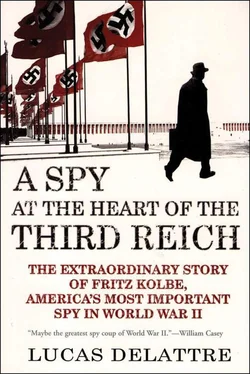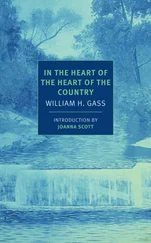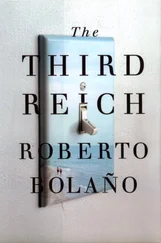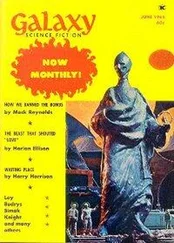Ulrich Sahm, Bodenwerder.
Serguei, Paris.
Thomas Sparr, Siedler Verlag, Berlin.
James Srodes, Washington.
Olivia Stasi, Paris.
Dr. Christoph Stamm, Friedrich-Ebert-Stiftung, Bonn.
Hansjakob Stehle, Vienna.
Ute Stiepani, Gedenkstätte Deutscher Widerstand, Berlin.
Jean-Pierre Tuquoi, Paris.
Professor Klaus Urner.
Professor Jean-Marie Vetter, Strasbourg.
Dr. Bernhard Weber-Brosamer, Franz Haniel & Co., Duisburg.
Abbot Paulus Weigele, Ottobeuren.
Professor Gerhard Weinberg, Chapel Hill, North Carolina.
Nigel West, Berkshire, England.
Neville Wylie, School of Politics, University of Nottingham.
Archives
1. Personal archives of Fritz Kolbe, Sydney
Peter Kolbe graciously made available his father’s archives, which he has preserved in Sydney. Fritz Kolbe kept a written record of most of the events of his life. His correspondence is extraordinarily rich (he even kept copies of letters he sent to his correspondents). A large number of documents covering the entire life of Kolbe was available for consultation. For several decades, these documents had been held in Bad Dürrheim, in the Black Forest region, by Maria Fritsch, Kolbe’s third wife, who died in June 2000 at the age of ninety-eight. The widow had not wanted to divulge them. Several historians and journalists vainly attempted to persuade her to open the files in her possession (for example, Klemens von Klemperer in the late 1970s, and Hansjakob Stehle of the weekly Die Zeit in 1986). She preferred to turn over all the documents in her possession to Peter Kolbe in Australia, to whom she sent, bit by bit, in the mail, the documents that she had preserved in the cellar of her house.
I have been able to consult all these documents—all previously unpublished—at the home of Peter Kolbe. Most of them were typed. When this was not the case (for example, the postwar correspondence between Fritz Kolbe and Ernst Kocherthaler), Peter Kolbe kindly took the trouble to decipher his father’s handwriting (very difficult to read because of old German script).
Among the most useful items was a fifty-nine-page typed document in German written by Gerald Mayer and Fritz Kolbe, unfortunately undated. Perhaps it was a sketch for the autobiography that Fritz Kolbe intended to write in the late 1960s. It is impossible to say. The text is written in the third person, and Kolbe is named in it “König.” Mayer’s and Kolbe’s points of view are blended together. The text is a bit novelistic (it begins: “On 18 August 1943, we meet him for the first time…”).
“The Story of George” (seven typed pages in English), written by Ernst Kocherthaler in the spring of 1945, was also of great help in reconstructing the life of Fritz Kolbe, along with various autobiographical documents that Kolbe wrote after the war (notably a ten-page autobiographical text in German, dated May 15, 1945). In the 1960s, Ernst Kocherthaler wrote another summary, “The Background of the George Story” (four typed pages in English, November 1964) to assist in the rehabilitation of his friend.
The problem with all these documents is that they present the point of view of a man on his own story, with all the distortions (voluntary or not) that that presupposes. “Human history is made up of many fables mixed with a few truths” (Chateaubriand). In every autobiographical narrative, the author seeks to justify his actions and to explain the coherence of his acts after the fact.
Hence the importance of all the dry and factual administrative documents, which are also found in abundance in Fritz Kolbe’s personal archives. Private and public correspondence, orders, passports, photographs… This type of document, which is invaluable, makes it possible to provide a multiplicity of perspectives on the picture.
2. United States National Archives, College Park
The U.S. National Archives (National Archives and Records Administration [NARA] announced in June 2000 the opening to the public of documents from the Office of Strategic Services (OSS), predecessor of the CIA. This major declassification procedure was the result of the Nazi War Crimes Disclosure Act, a law passed by Congress in 1998 intended to facilitate informing the public about still-hidden aspects of the Second World War, at a time when there was a renewed wish for truth and transparency about a past still open to debate and polemic (“Nazi gold,” “indemnification for slave labor in the Third Reich,” etc.).
This huge mountain of declassified documents (400,000 pages of text) contained a subset that did not go without notice: the totality of the 1,600 documents provided to the Americans by Fritz Kolbe, alias “George Wood,” commonly presented as the best source of information to the Allies during the war. These declassified documents (the entire Boston series) contain all the transcriptions in English of the German diplomatic cables classified “top secret” that Fritz Kolbe brought to Bern between 1943 and 1945. Other documents supplied by “Wood” (copies of originals in German, Kappa messages sent by OSS Bern to Washington, various memoranda of the Bern office of the OSS, etc.) had already been open to the public for several years. These files can be consulted in the National Archives building in College Park, MD, near Washington.
All the OSS documents are filed in the category Record Group 226 (RG 226), and in many subcategories that require patience to explore (entries 210 to 220, 190c, 134, 121, 138, 162, et al.).
Thanks to the OSS archives, Fritz Kolbe’s activities can be observed from the outside: it is possible to retrace with relative precision the deeds of the spy beginning in August 1943, the date of his first meeting with Allen Dulles in Bern. The problem is that the OSS documents are not always dated—the Kappa messages are, but not the documents of the Boston series—and they are scattered through many boxes with no apparent order.
3. Allen W. Dulles Papers, Princeton
The private archives of Allen Dulles were bequeathed to Princeton University by his widow, Clover Todd Dulles, in 1973. They contain many very valuable items, notably Dulles’s personal correspondence (for example, with Fritz Kolbe, Gerald Mayer, and Ernst Kocherthaler), as well as unpublished manuscripts in which the story of “George Wood” appears. Allen Dulles accumulated many documents on Fritz Kolbe, items that have never been published. Unfortunately, these documents are often undated.
4. Archives of the German Foreign Ministry, Berlin
The German Foreign Ministry in Berlin lost some of its archives during the bombings between 1943 and 1945. Part of the Fritz Kolbe file (nos. 007680 and 007681) was destroyed. The entirety of some files (Gertrud von Heimerdinger, for example) has completely disappeared. But there is a great deal of information on Fritz Kolbe’s colleagues, and particularly his superiors (files on Johannes von Welczeck, Karl Ritter, and Rudolf Leitner). The archives of the German legation in Bern are particularly well preserved. Many internal ministry circulars, full of information, were also consulted.
5. Swiss Federal Archives, Bern
Several files of the “public ministry” (files comparable to those of the French security services) were consulted, notably those on Ernst Kocherthaler and Gerald Mayer. The Swiss Federal Archives also contain several police documents relative to the mysterious encounter between Fritz Kolbe and the head of the German legation, Otto Köcher, in late April 1945.
6. German Federal Archives, Koblenz
Rudolf Pechel’s archives are kept in Koblenz. Fritz Kolbe’s participation in the Deutsche Rundschau from 1950 to 1954 would have been unknown were it not for these files.
Читать дальше











